Comparison of Market Segmentation and Targeting in African Airlines
VerifiedAdded on 2022/09/15
|38
|9979
|40
Report
AI Summary
This report provides an in-depth analysis of market segmentation and targeting strategies employed by African airline corporations, with a specific focus on Ethiopian Airlines, South African Airways, and Kenya Airways. The study utilizes a pragmatic research philosophy, descriptive research design, and a deductive research approach, relying on secondary data and qualitative data analysis. The findings reveal that Ethiopian Airlines primarily targets low-cost carrier service customers, while South African Airways, Kenya Airways, and others cater to economic or business class segments. The report highlights that Ethiopian Airlines emphasizes cost, whereas the others focus on quality to establish their unique position within the African airline industry and influence customer behavior. The success of Ethiopian Airlines underscores the effectiveness of its segmentation, targeting, and positioning strategies, leading to a competitive advantage in the African airline market. The report concludes with recommendations for personalized advertisements, targeting low-cost carrier segments, and a focus on cost to create a distinctive market image.
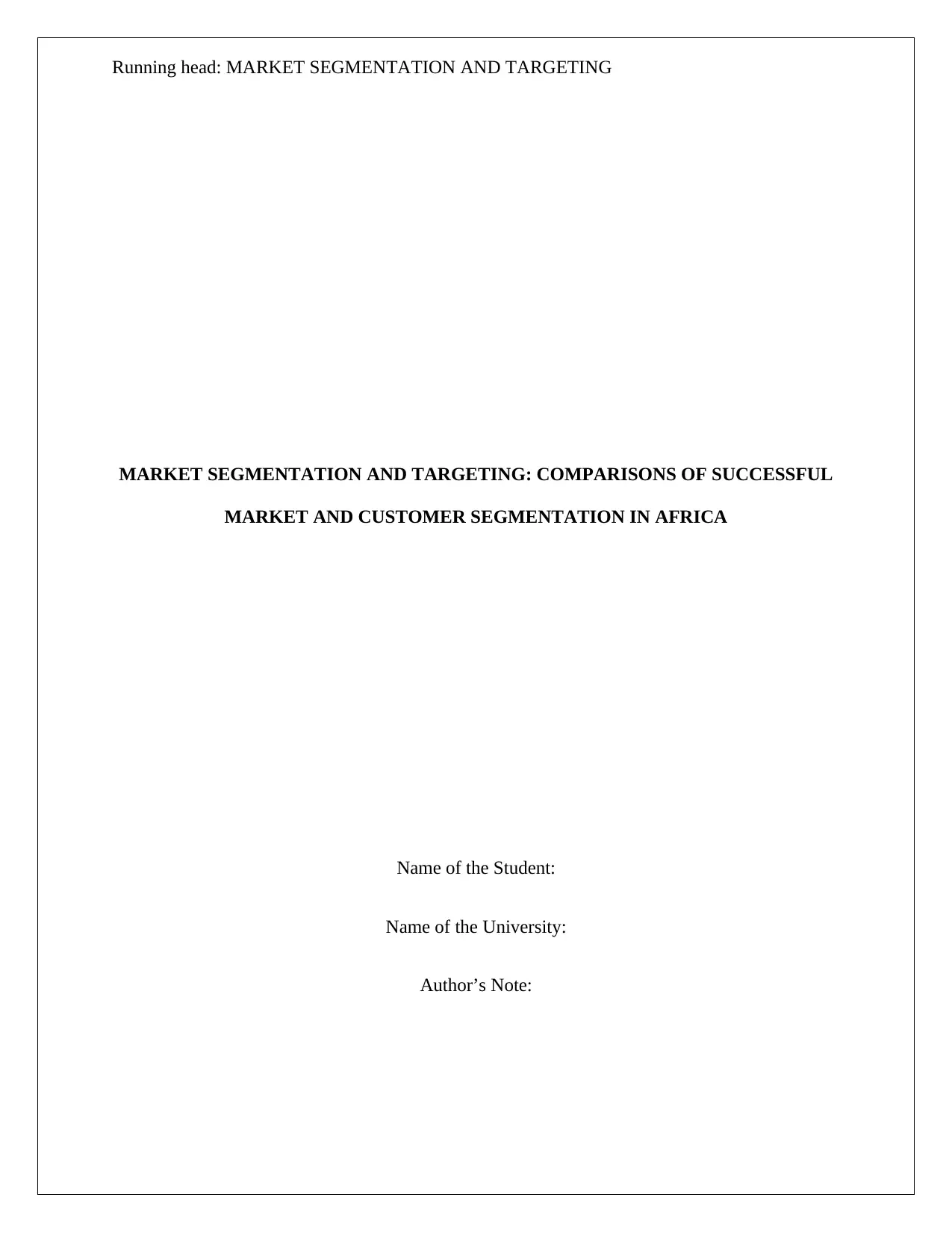
Running head: MARKET SEGMENTATION AND TARGETING
MARKET SEGMENTATION AND TARGETING: COMPARISONS OF SUCCESSFUL
MARKET AND CUSTOMER SEGMENTATION IN AFRICA
Name of the Student:
Name of the University:
Author’s Note:
MARKET SEGMENTATION AND TARGETING: COMPARISONS OF SUCCESSFUL
MARKET AND CUSTOMER SEGMENTATION IN AFRICA
Name of the Student:
Name of the University:
Author’s Note:
Paraphrase This Document
Need a fresh take? Get an instant paraphrase of this document with our AI Paraphraser
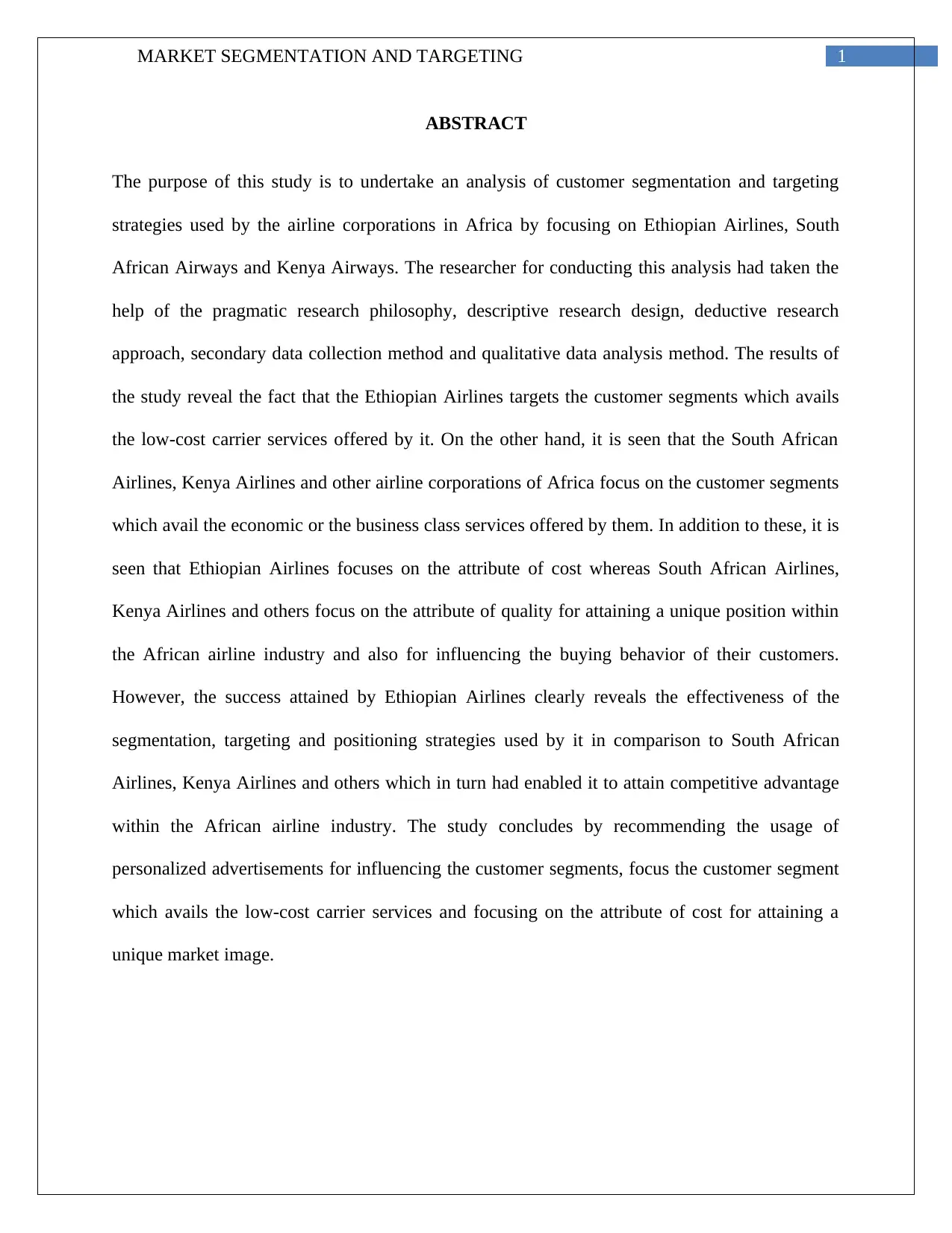
1MARKET SEGMENTATION AND TARGETING
ABSTRACT
The purpose of this study is to undertake an analysis of customer segmentation and targeting
strategies used by the airline corporations in Africa by focusing on Ethiopian Airlines, South
African Airways and Kenya Airways. The researcher for conducting this analysis had taken the
help of the pragmatic research philosophy, descriptive research design, deductive research
approach, secondary data collection method and qualitative data analysis method. The results of
the study reveal the fact that the Ethiopian Airlines targets the customer segments which avails
the low-cost carrier services offered by it. On the other hand, it is seen that the South African
Airlines, Kenya Airlines and other airline corporations of Africa focus on the customer segments
which avail the economic or the business class services offered by them. In addition to these, it is
seen that Ethiopian Airlines focuses on the attribute of cost whereas South African Airlines,
Kenya Airlines and others focus on the attribute of quality for attaining a unique position within
the African airline industry and also for influencing the buying behavior of their customers.
However, the success attained by Ethiopian Airlines clearly reveals the effectiveness of the
segmentation, targeting and positioning strategies used by it in comparison to South African
Airlines, Kenya Airlines and others which in turn had enabled it to attain competitive advantage
within the African airline industry. The study concludes by recommending the usage of
personalized advertisements for influencing the customer segments, focus the customer segment
which avails the low-cost carrier services and focusing on the attribute of cost for attaining a
unique market image.
ABSTRACT
The purpose of this study is to undertake an analysis of customer segmentation and targeting
strategies used by the airline corporations in Africa by focusing on Ethiopian Airlines, South
African Airways and Kenya Airways. The researcher for conducting this analysis had taken the
help of the pragmatic research philosophy, descriptive research design, deductive research
approach, secondary data collection method and qualitative data analysis method. The results of
the study reveal the fact that the Ethiopian Airlines targets the customer segments which avails
the low-cost carrier services offered by it. On the other hand, it is seen that the South African
Airlines, Kenya Airlines and other airline corporations of Africa focus on the customer segments
which avail the economic or the business class services offered by them. In addition to these, it is
seen that Ethiopian Airlines focuses on the attribute of cost whereas South African Airlines,
Kenya Airlines and others focus on the attribute of quality for attaining a unique position within
the African airline industry and also for influencing the buying behavior of their customers.
However, the success attained by Ethiopian Airlines clearly reveals the effectiveness of the
segmentation, targeting and positioning strategies used by it in comparison to South African
Airlines, Kenya Airlines and others which in turn had enabled it to attain competitive advantage
within the African airline industry. The study concludes by recommending the usage of
personalized advertisements for influencing the customer segments, focus the customer segment
which avails the low-cost carrier services and focusing on the attribute of cost for attaining a
unique market image.
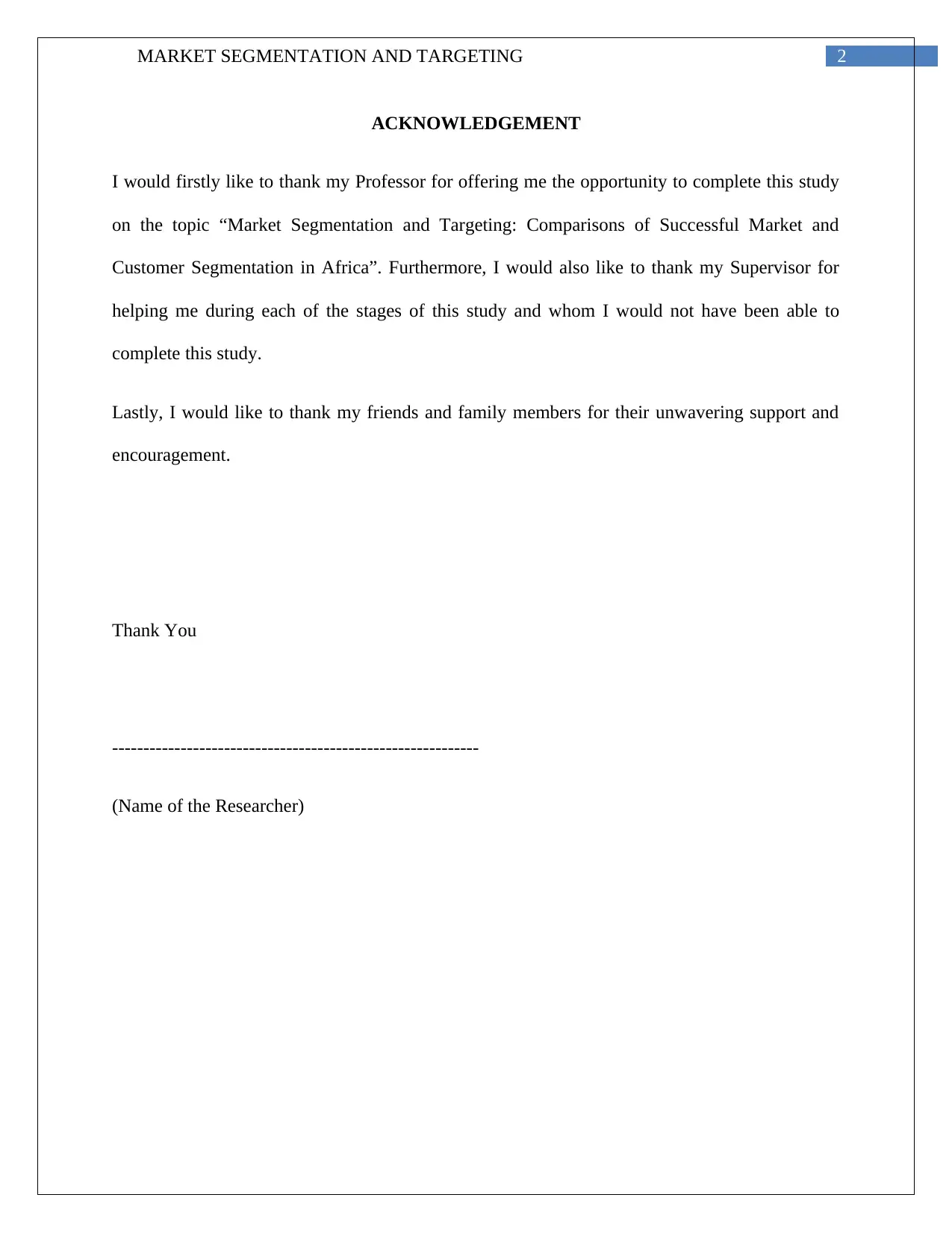
2MARKET SEGMENTATION AND TARGETING
ACKNOWLEDGEMENT
I would firstly like to thank my Professor for offering me the opportunity to complete this study
on the topic “Market Segmentation and Targeting: Comparisons of Successful Market and
Customer Segmentation in Africa”. Furthermore, I would also like to thank my Supervisor for
helping me during each of the stages of this study and whom I would not have been able to
complete this study.
Lastly, I would like to thank my friends and family members for their unwavering support and
encouragement.
Thank You
-----------------------------------------------------------
(Name of the Researcher)
ACKNOWLEDGEMENT
I would firstly like to thank my Professor for offering me the opportunity to complete this study
on the topic “Market Segmentation and Targeting: Comparisons of Successful Market and
Customer Segmentation in Africa”. Furthermore, I would also like to thank my Supervisor for
helping me during each of the stages of this study and whom I would not have been able to
complete this study.
Lastly, I would like to thank my friends and family members for their unwavering support and
encouragement.
Thank You
-----------------------------------------------------------
(Name of the Researcher)
⊘ This is a preview!⊘
Do you want full access?
Subscribe today to unlock all pages.

Trusted by 1+ million students worldwide
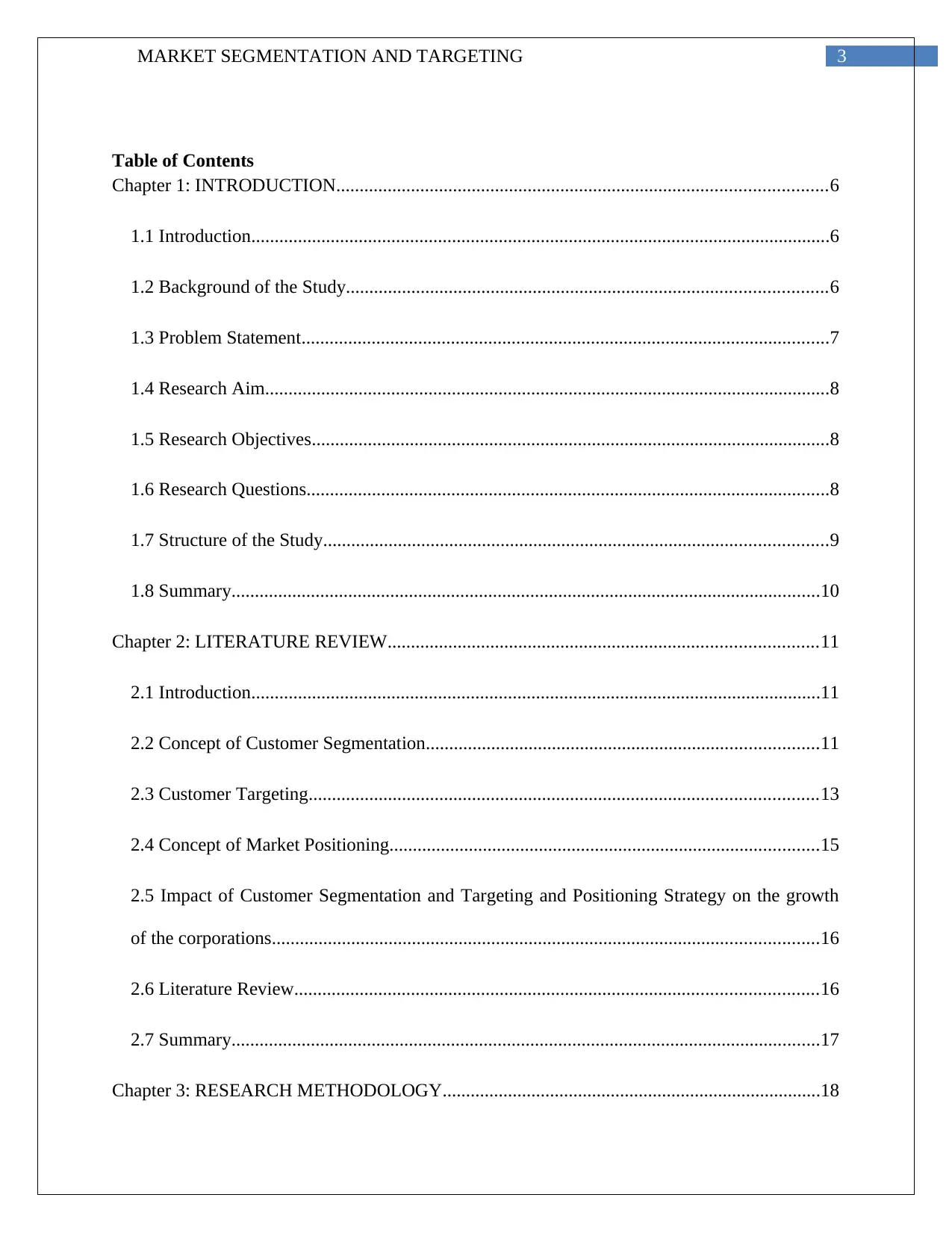
3MARKET SEGMENTATION AND TARGETING
Table of Contents
Chapter 1: INTRODUCTION.........................................................................................................6
1.1 Introduction............................................................................................................................6
1.2 Background of the Study.......................................................................................................6
1.3 Problem Statement.................................................................................................................7
1.4 Research Aim.........................................................................................................................8
1.5 Research Objectives...............................................................................................................8
1.6 Research Questions................................................................................................................8
1.7 Structure of the Study............................................................................................................9
1.8 Summary..............................................................................................................................10
Chapter 2: LITERATURE REVIEW............................................................................................11
2.1 Introduction..........................................................................................................................11
2.2 Concept of Customer Segmentation....................................................................................11
2.3 Customer Targeting.............................................................................................................13
2.4 Concept of Market Positioning............................................................................................15
2.5 Impact of Customer Segmentation and Targeting and Positioning Strategy on the growth
of the corporations.....................................................................................................................16
2.6 Literature Review................................................................................................................16
2.7 Summary..............................................................................................................................17
Chapter 3: RESEARCH METHODOLOGY.................................................................................18
Table of Contents
Chapter 1: INTRODUCTION.........................................................................................................6
1.1 Introduction............................................................................................................................6
1.2 Background of the Study.......................................................................................................6
1.3 Problem Statement.................................................................................................................7
1.4 Research Aim.........................................................................................................................8
1.5 Research Objectives...............................................................................................................8
1.6 Research Questions................................................................................................................8
1.7 Structure of the Study............................................................................................................9
1.8 Summary..............................................................................................................................10
Chapter 2: LITERATURE REVIEW............................................................................................11
2.1 Introduction..........................................................................................................................11
2.2 Concept of Customer Segmentation....................................................................................11
2.3 Customer Targeting.............................................................................................................13
2.4 Concept of Market Positioning............................................................................................15
2.5 Impact of Customer Segmentation and Targeting and Positioning Strategy on the growth
of the corporations.....................................................................................................................16
2.6 Literature Review................................................................................................................16
2.7 Summary..............................................................................................................................17
Chapter 3: RESEARCH METHODOLOGY.................................................................................18
Paraphrase This Document
Need a fresh take? Get an instant paraphrase of this document with our AI Paraphraser

4MARKET SEGMENTATION AND TARGETING
3.1 Introduction..........................................................................................................................18
3.2 Research Philosophy............................................................................................................18
3.3 Research Approach..............................................................................................................18
3.4 Research Design..................................................................................................................19
3.5 Data Collection Method.......................................................................................................19
3.6 Data Analysis Method.........................................................................................................20
3.7 Limitations of Study............................................................................................................20
3.8 Summary..............................................................................................................................20
Chapter 4: FINDINGS AND DISCUSSION.................................................................................22
4.1 Introduction..........................................................................................................................22
4.2 Presentation of Findings......................................................................................................22
4.3 Discussion of the Findings...................................................................................................25
4.4 Summary..............................................................................................................................28
Chapter 5: CONCLUSION AND RECOMMENDATIONS........................................................30
5.1 Conclusion...........................................................................................................................30
5.2 Recommendations................................................................................................................30
5.3 Future Scope........................................................................................................................31
References......................................................................................................................................32
3.1 Introduction..........................................................................................................................18
3.2 Research Philosophy............................................................................................................18
3.3 Research Approach..............................................................................................................18
3.4 Research Design..................................................................................................................19
3.5 Data Collection Method.......................................................................................................19
3.6 Data Analysis Method.........................................................................................................20
3.7 Limitations of Study............................................................................................................20
3.8 Summary..............................................................................................................................20
Chapter 4: FINDINGS AND DISCUSSION.................................................................................22
4.1 Introduction..........................................................................................................................22
4.2 Presentation of Findings......................................................................................................22
4.3 Discussion of the Findings...................................................................................................25
4.4 Summary..............................................................................................................................28
Chapter 5: CONCLUSION AND RECOMMENDATIONS........................................................30
5.1 Conclusion...........................................................................................................................30
5.2 Recommendations................................................................................................................30
5.3 Future Scope........................................................................................................................31
References......................................................................................................................................32
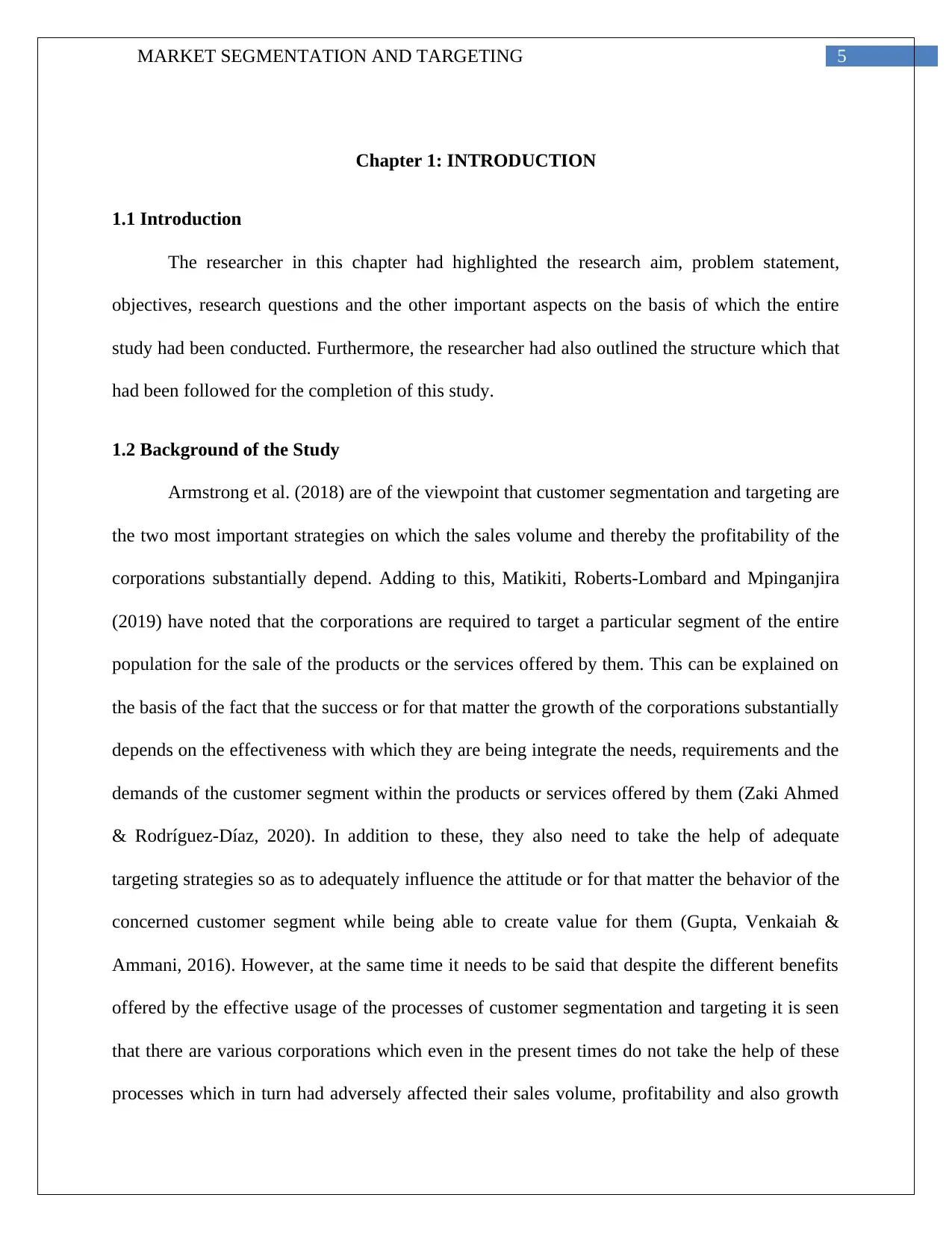
5MARKET SEGMENTATION AND TARGETING
Chapter 1: INTRODUCTION
1.1 Introduction
The researcher in this chapter had highlighted the research aim, problem statement,
objectives, research questions and the other important aspects on the basis of which the entire
study had been conducted. Furthermore, the researcher had also outlined the structure which that
had been followed for the completion of this study.
1.2 Background of the Study
Armstrong et al. (2018) are of the viewpoint that customer segmentation and targeting are
the two most important strategies on which the sales volume and thereby the profitability of the
corporations substantially depend. Adding to this, Matikiti, Roberts-Lombard and Mpinganjira
(2019) have noted that the corporations are required to target a particular segment of the entire
population for the sale of the products or the services offered by them. This can be explained on
the basis of the fact that the success or for that matter the growth of the corporations substantially
depends on the effectiveness with which they are being integrate the needs, requirements and the
demands of the customer segment within the products or services offered by them (Zaki Ahmed
& Rodríguez-Díaz, 2020). In addition to these, they also need to take the help of adequate
targeting strategies so as to adequately influence the attitude or for that matter the behavior of the
concerned customer segment while being able to create value for them (Gupta, Venkaiah &
Ammani, 2016). However, at the same time it needs to be said that despite the different benefits
offered by the effective usage of the processes of customer segmentation and targeting it is seen
that there are various corporations which even in the present times do not take the help of these
processes which in turn had adversely affected their sales volume, profitability and also growth
Chapter 1: INTRODUCTION
1.1 Introduction
The researcher in this chapter had highlighted the research aim, problem statement,
objectives, research questions and the other important aspects on the basis of which the entire
study had been conducted. Furthermore, the researcher had also outlined the structure which that
had been followed for the completion of this study.
1.2 Background of the Study
Armstrong et al. (2018) are of the viewpoint that customer segmentation and targeting are
the two most important strategies on which the sales volume and thereby the profitability of the
corporations substantially depend. Adding to this, Matikiti, Roberts-Lombard and Mpinganjira
(2019) have noted that the corporations are required to target a particular segment of the entire
population for the sale of the products or the services offered by them. This can be explained on
the basis of the fact that the success or for that matter the growth of the corporations substantially
depends on the effectiveness with which they are being integrate the needs, requirements and the
demands of the customer segment within the products or services offered by them (Zaki Ahmed
& Rodríguez-Díaz, 2020). In addition to these, they also need to take the help of adequate
targeting strategies so as to adequately influence the attitude or for that matter the behavior of the
concerned customer segment while being able to create value for them (Gupta, Venkaiah &
Ammani, 2016). However, at the same time it needs to be said that despite the different benefits
offered by the effective usage of the processes of customer segmentation and targeting it is seen
that there are various corporations which even in the present times do not take the help of these
processes which in turn had adversely affected their sales volume, profitability and also growth
⊘ This is a preview!⊘
Do you want full access?
Subscribe today to unlock all pages.

Trusted by 1+ million students worldwide
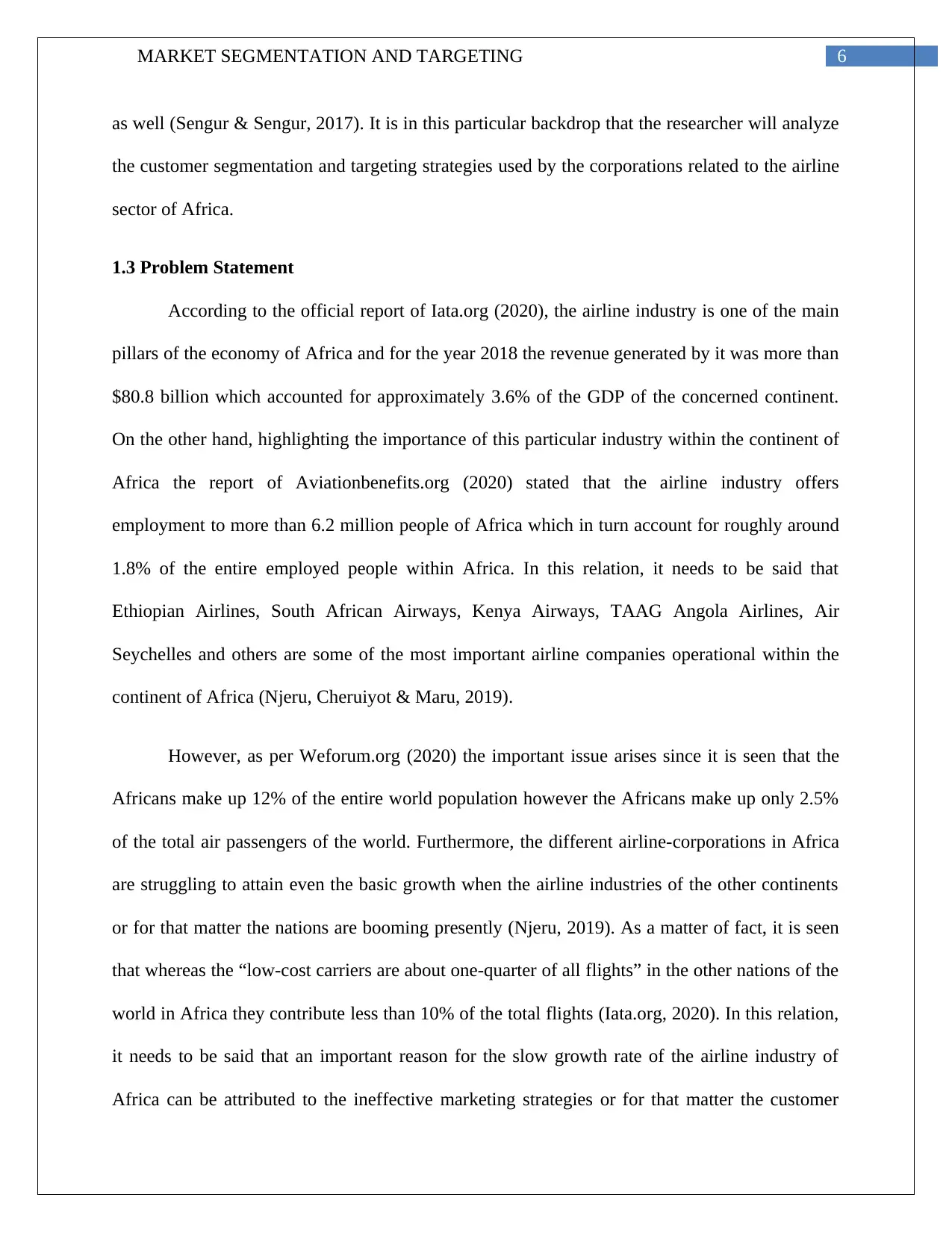
6MARKET SEGMENTATION AND TARGETING
as well (Sengur & Sengur, 2017). It is in this particular backdrop that the researcher will analyze
the customer segmentation and targeting strategies used by the corporations related to the airline
sector of Africa.
1.3 Problem Statement
According to the official report of Iata.org (2020), the airline industry is one of the main
pillars of the economy of Africa and for the year 2018 the revenue generated by it was more than
$80.8 billion which accounted for approximately 3.6% of the GDP of the concerned continent.
On the other hand, highlighting the importance of this particular industry within the continent of
Africa the report of Aviationbenefits.org (2020) stated that the airline industry offers
employment to more than 6.2 million people of Africa which in turn account for roughly around
1.8% of the entire employed people within Africa. In this relation, it needs to be said that
Ethiopian Airlines, South African Airways, Kenya Airways, TAAG Angola Airlines, Air
Seychelles and others are some of the most important airline companies operational within the
continent of Africa (Njeru, Cheruiyot & Maru, 2019).
However, as per Weforum.org (2020) the important issue arises since it is seen that the
Africans make up 12% of the entire world population however the Africans make up only 2.5%
of the total air passengers of the world. Furthermore, the different airline-corporations in Africa
are struggling to attain even the basic growth when the airline industries of the other continents
or for that matter the nations are booming presently (Njeru, 2019). As a matter of fact, it is seen
that whereas the “low-cost carriers are about one-quarter of all flights” in the other nations of the
world in Africa they contribute less than 10% of the total flights (Iata.org, 2020). In this relation,
it needs to be said that an important reason for the slow growth rate of the airline industry of
Africa can be attributed to the ineffective marketing strategies or for that matter the customer
as well (Sengur & Sengur, 2017). It is in this particular backdrop that the researcher will analyze
the customer segmentation and targeting strategies used by the corporations related to the airline
sector of Africa.
1.3 Problem Statement
According to the official report of Iata.org (2020), the airline industry is one of the main
pillars of the economy of Africa and for the year 2018 the revenue generated by it was more than
$80.8 billion which accounted for approximately 3.6% of the GDP of the concerned continent.
On the other hand, highlighting the importance of this particular industry within the continent of
Africa the report of Aviationbenefits.org (2020) stated that the airline industry offers
employment to more than 6.2 million people of Africa which in turn account for roughly around
1.8% of the entire employed people within Africa. In this relation, it needs to be said that
Ethiopian Airlines, South African Airways, Kenya Airways, TAAG Angola Airlines, Air
Seychelles and others are some of the most important airline companies operational within the
continent of Africa (Njeru, Cheruiyot & Maru, 2019).
However, as per Weforum.org (2020) the important issue arises since it is seen that the
Africans make up 12% of the entire world population however the Africans make up only 2.5%
of the total air passengers of the world. Furthermore, the different airline-corporations in Africa
are struggling to attain even the basic growth when the airline industries of the other continents
or for that matter the nations are booming presently (Njeru, 2019). As a matter of fact, it is seen
that whereas the “low-cost carriers are about one-quarter of all flights” in the other nations of the
world in Africa they contribute less than 10% of the total flights (Iata.org, 2020). In this relation,
it needs to be said that an important reason for the slow growth rate of the airline industry of
Africa can be attributed to the ineffective marketing strategies or for that matter the customer
Paraphrase This Document
Need a fresh take? Get an instant paraphrase of this document with our AI Paraphraser
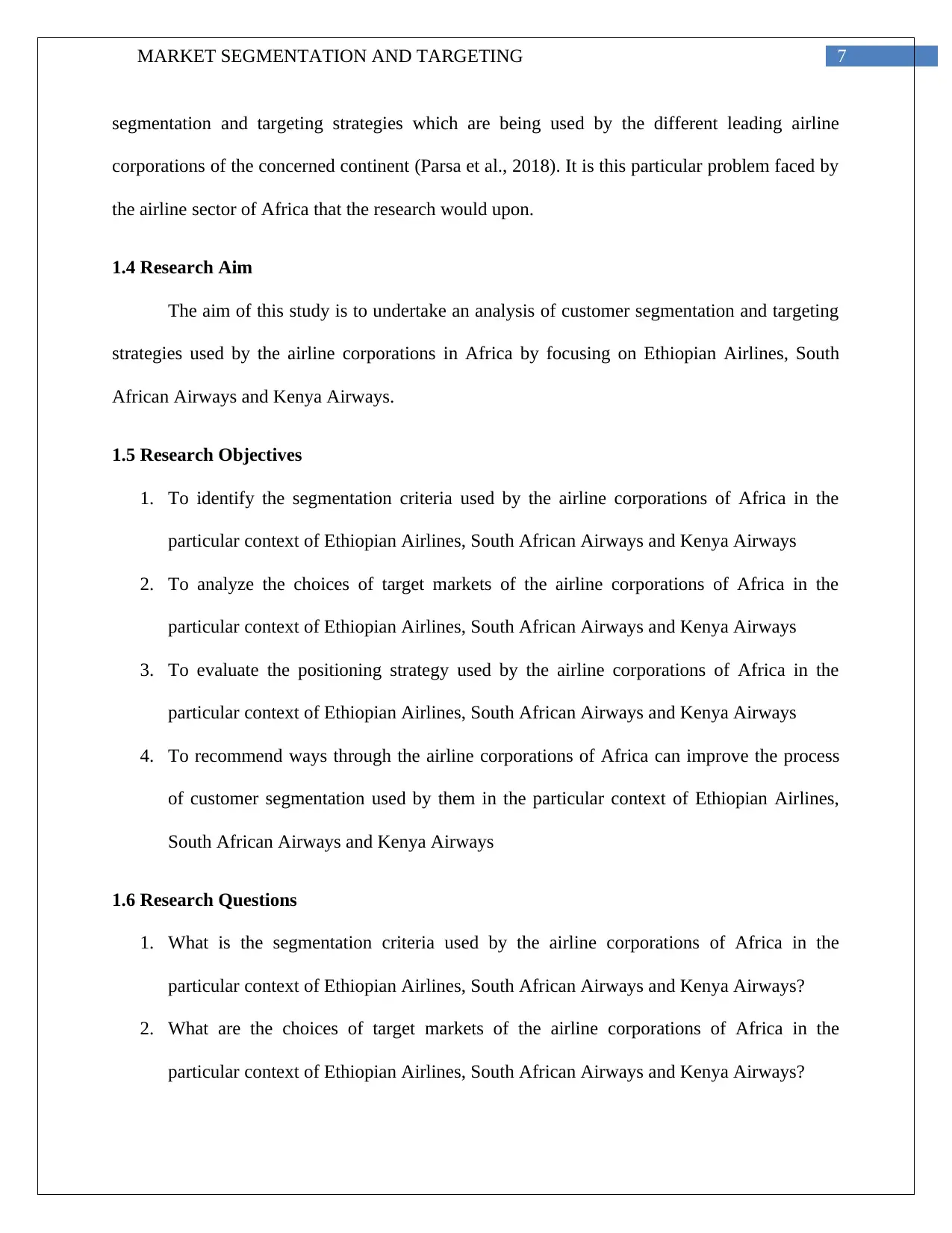
7MARKET SEGMENTATION AND TARGETING
segmentation and targeting strategies which are being used by the different leading airline
corporations of the concerned continent (Parsa et al., 2018). It is this particular problem faced by
the airline sector of Africa that the research would upon.
1.4 Research Aim
The aim of this study is to undertake an analysis of customer segmentation and targeting
strategies used by the airline corporations in Africa by focusing on Ethiopian Airlines, South
African Airways and Kenya Airways.
1.5 Research Objectives
1. To identify the segmentation criteria used by the airline corporations of Africa in the
particular context of Ethiopian Airlines, South African Airways and Kenya Airways
2. To analyze the choices of target markets of the airline corporations of Africa in the
particular context of Ethiopian Airlines, South African Airways and Kenya Airways
3. To evaluate the positioning strategy used by the airline corporations of Africa in the
particular context of Ethiopian Airlines, South African Airways and Kenya Airways
4. To recommend ways through the airline corporations of Africa can improve the process
of customer segmentation used by them in the particular context of Ethiopian Airlines,
South African Airways and Kenya Airways
1.6 Research Questions
1. What is the segmentation criteria used by the airline corporations of Africa in the
particular context of Ethiopian Airlines, South African Airways and Kenya Airways?
2. What are the choices of target markets of the airline corporations of Africa in the
particular context of Ethiopian Airlines, South African Airways and Kenya Airways?
segmentation and targeting strategies which are being used by the different leading airline
corporations of the concerned continent (Parsa et al., 2018). It is this particular problem faced by
the airline sector of Africa that the research would upon.
1.4 Research Aim
The aim of this study is to undertake an analysis of customer segmentation and targeting
strategies used by the airline corporations in Africa by focusing on Ethiopian Airlines, South
African Airways and Kenya Airways.
1.5 Research Objectives
1. To identify the segmentation criteria used by the airline corporations of Africa in the
particular context of Ethiopian Airlines, South African Airways and Kenya Airways
2. To analyze the choices of target markets of the airline corporations of Africa in the
particular context of Ethiopian Airlines, South African Airways and Kenya Airways
3. To evaluate the positioning strategy used by the airline corporations of Africa in the
particular context of Ethiopian Airlines, South African Airways and Kenya Airways
4. To recommend ways through the airline corporations of Africa can improve the process
of customer segmentation used by them in the particular context of Ethiopian Airlines,
South African Airways and Kenya Airways
1.6 Research Questions
1. What is the segmentation criteria used by the airline corporations of Africa in the
particular context of Ethiopian Airlines, South African Airways and Kenya Airways?
2. What are the choices of target markets of the airline corporations of Africa in the
particular context of Ethiopian Airlines, South African Airways and Kenya Airways?
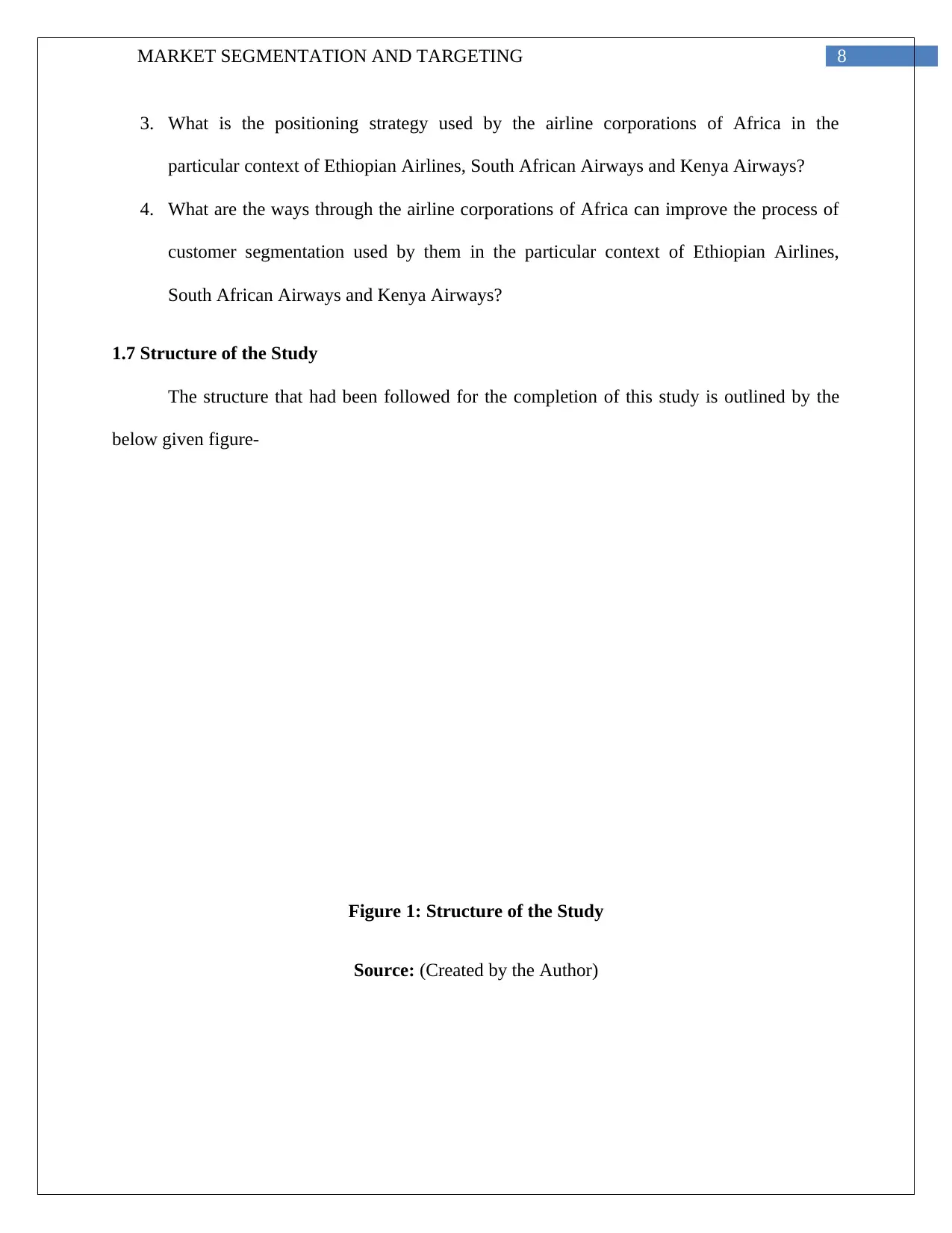
8MARKET SEGMENTATION AND TARGETING
3. What is the positioning strategy used by the airline corporations of Africa in the
particular context of Ethiopian Airlines, South African Airways and Kenya Airways?
4. What are the ways through the airline corporations of Africa can improve the process of
customer segmentation used by them in the particular context of Ethiopian Airlines,
South African Airways and Kenya Airways?
1.7 Structure of the Study
The structure that had been followed for the completion of this study is outlined by the
below given figure-
Figure 1: Structure of the Study
Source: (Created by the Author)
3. What is the positioning strategy used by the airline corporations of Africa in the
particular context of Ethiopian Airlines, South African Airways and Kenya Airways?
4. What are the ways through the airline corporations of Africa can improve the process of
customer segmentation used by them in the particular context of Ethiopian Airlines,
South African Airways and Kenya Airways?
1.7 Structure of the Study
The structure that had been followed for the completion of this study is outlined by the
below given figure-
Figure 1: Structure of the Study
Source: (Created by the Author)
⊘ This is a preview!⊘
Do you want full access?
Subscribe today to unlock all pages.

Trusted by 1+ million students worldwide
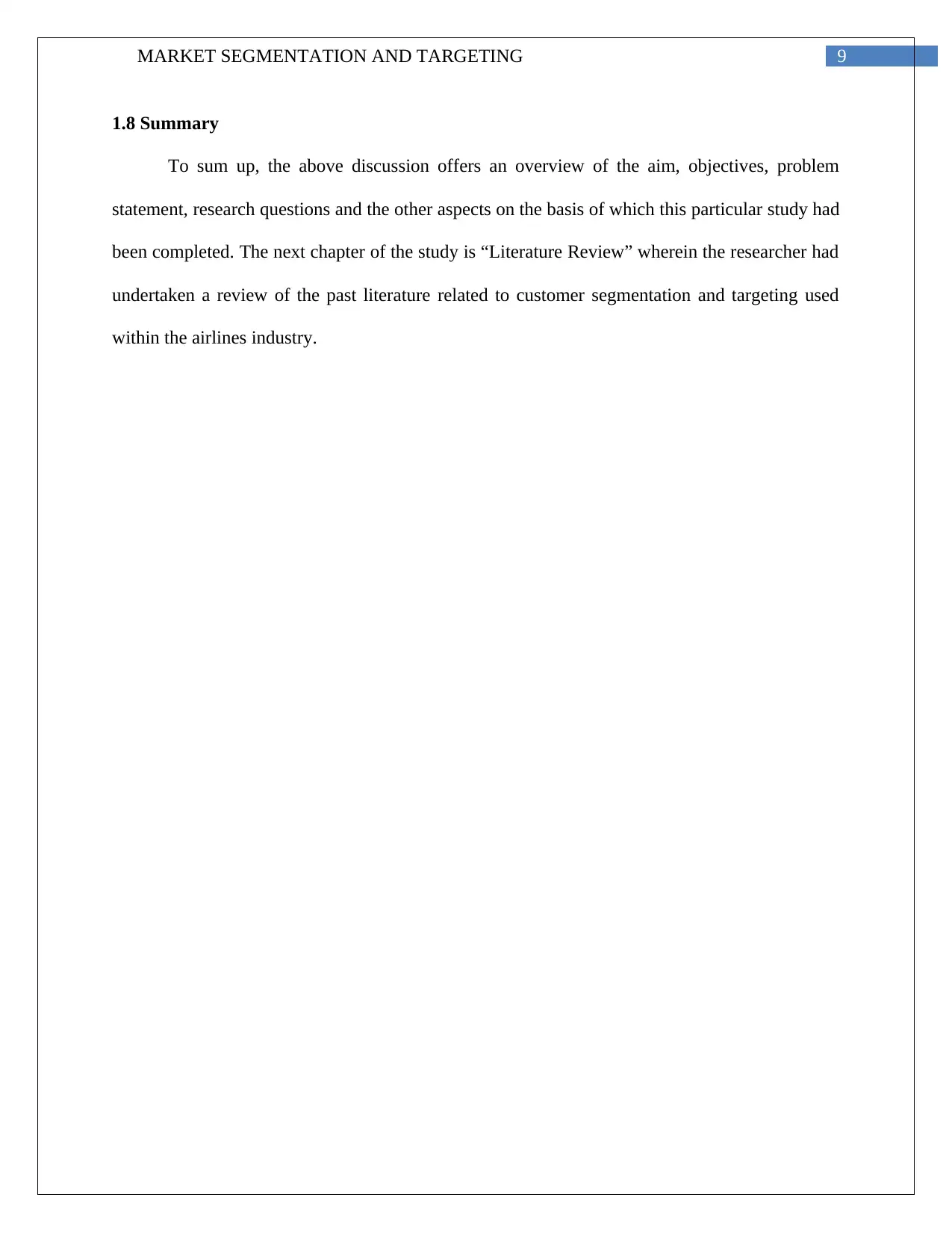
9MARKET SEGMENTATION AND TARGETING
1.8 Summary
To sum up, the above discussion offers an overview of the aim, objectives, problem
statement, research questions and the other aspects on the basis of which this particular study had
been completed. The next chapter of the study is “Literature Review” wherein the researcher had
undertaken a review of the past literature related to customer segmentation and targeting used
within the airlines industry.
1.8 Summary
To sum up, the above discussion offers an overview of the aim, objectives, problem
statement, research questions and the other aspects on the basis of which this particular study had
been completed. The next chapter of the study is “Literature Review” wherein the researcher had
undertaken a review of the past literature related to customer segmentation and targeting used
within the airlines industry.
Paraphrase This Document
Need a fresh take? Get an instant paraphrase of this document with our AI Paraphraser
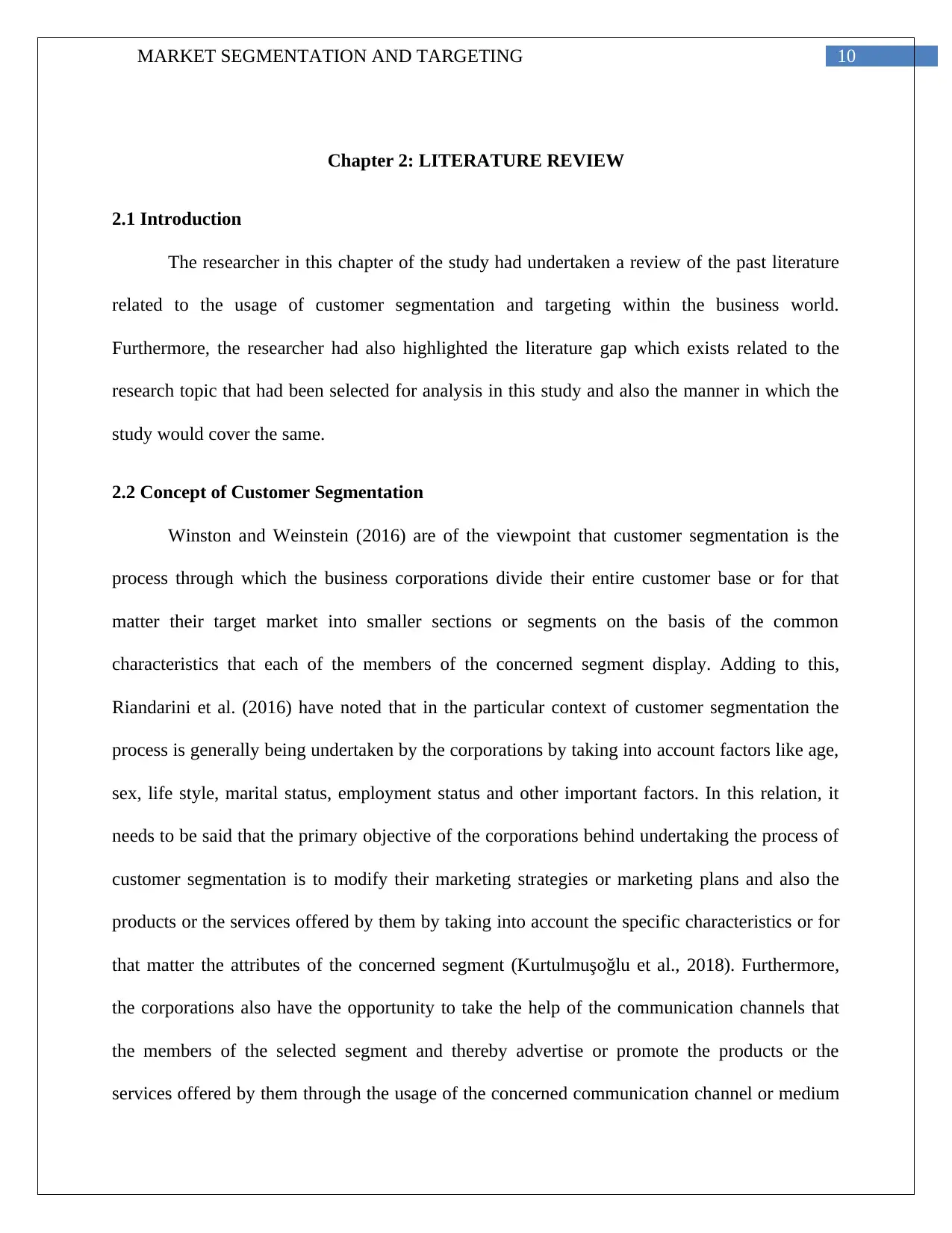
10MARKET SEGMENTATION AND TARGETING
Chapter 2: LITERATURE REVIEW
2.1 Introduction
The researcher in this chapter of the study had undertaken a review of the past literature
related to the usage of customer segmentation and targeting within the business world.
Furthermore, the researcher had also highlighted the literature gap which exists related to the
research topic that had been selected for analysis in this study and also the manner in which the
study would cover the same.
2.2 Concept of Customer Segmentation
Winston and Weinstein (2016) are of the viewpoint that customer segmentation is the
process through which the business corporations divide their entire customer base or for that
matter their target market into smaller sections or segments on the basis of the common
characteristics that each of the members of the concerned segment display. Adding to this,
Riandarini et al. (2016) have noted that in the particular context of customer segmentation the
process is generally being undertaken by the corporations by taking into account factors like age,
sex, life style, marital status, employment status and other important factors. In this relation, it
needs to be said that the primary objective of the corporations behind undertaking the process of
customer segmentation is to modify their marketing strategies or marketing plans and also the
products or the services offered by them by taking into account the specific characteristics or for
that matter the attributes of the concerned segment (Kurtulmuşoğlu et al., 2018). Furthermore,
the corporations also have the opportunity to take the help of the communication channels that
the members of the selected segment and thereby advertise or promote the products or the
services offered by them through the usage of the concerned communication channel or medium
Chapter 2: LITERATURE REVIEW
2.1 Introduction
The researcher in this chapter of the study had undertaken a review of the past literature
related to the usage of customer segmentation and targeting within the business world.
Furthermore, the researcher had also highlighted the literature gap which exists related to the
research topic that had been selected for analysis in this study and also the manner in which the
study would cover the same.
2.2 Concept of Customer Segmentation
Winston and Weinstein (2016) are of the viewpoint that customer segmentation is the
process through which the business corporations divide their entire customer base or for that
matter their target market into smaller sections or segments on the basis of the common
characteristics that each of the members of the concerned segment display. Adding to this,
Riandarini et al. (2016) have noted that in the particular context of customer segmentation the
process is generally being undertaken by the corporations by taking into account factors like age,
sex, life style, marital status, employment status and other important factors. In this relation, it
needs to be said that the primary objective of the corporations behind undertaking the process of
customer segmentation is to modify their marketing strategies or marketing plans and also the
products or the services offered by them by taking into account the specific characteristics or for
that matter the attributes of the concerned segment (Kurtulmuşoğlu et al., 2018). Furthermore,
the corporations also have the opportunity to take the help of the communication channels that
the members of the selected segment and thereby advertise or promote the products or the
services offered by them through the usage of the concerned communication channel or medium
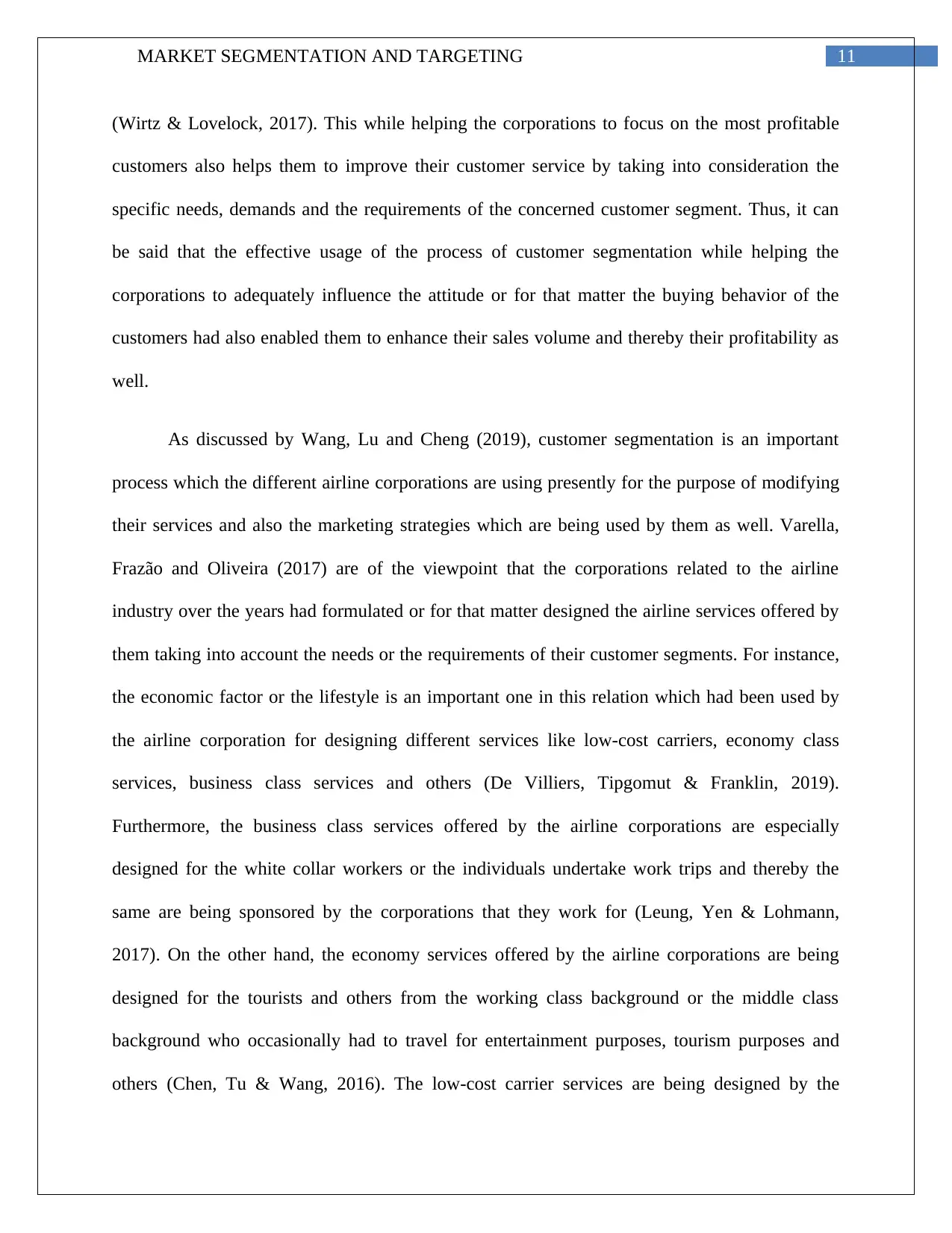
11MARKET SEGMENTATION AND TARGETING
(Wirtz & Lovelock, 2017). This while helping the corporations to focus on the most profitable
customers also helps them to improve their customer service by taking into consideration the
specific needs, demands and the requirements of the concerned customer segment. Thus, it can
be said that the effective usage of the process of customer segmentation while helping the
corporations to adequately influence the attitude or for that matter the buying behavior of the
customers had also enabled them to enhance their sales volume and thereby their profitability as
well.
As discussed by Wang, Lu and Cheng (2019), customer segmentation is an important
process which the different airline corporations are using presently for the purpose of modifying
their services and also the marketing strategies which are being used by them as well. Varella,
Frazão and Oliveira (2017) are of the viewpoint that the corporations related to the airline
industry over the years had formulated or for that matter designed the airline services offered by
them taking into account the needs or the requirements of their customer segments. For instance,
the economic factor or the lifestyle is an important one in this relation which had been used by
the airline corporation for designing different services like low-cost carriers, economy class
services, business class services and others (De Villiers, Tipgomut & Franklin, 2019).
Furthermore, the business class services offered by the airline corporations are especially
designed for the white collar workers or the individuals undertake work trips and thereby the
same are being sponsored by the corporations that they work for (Leung, Yen & Lohmann,
2017). On the other hand, the economy services offered by the airline corporations are being
designed for the tourists and others from the working class background or the middle class
background who occasionally had to travel for entertainment purposes, tourism purposes and
others (Chen, Tu & Wang, 2016). The low-cost carrier services are being designed by the
(Wirtz & Lovelock, 2017). This while helping the corporations to focus on the most profitable
customers also helps them to improve their customer service by taking into consideration the
specific needs, demands and the requirements of the concerned customer segment. Thus, it can
be said that the effective usage of the process of customer segmentation while helping the
corporations to adequately influence the attitude or for that matter the buying behavior of the
customers had also enabled them to enhance their sales volume and thereby their profitability as
well.
As discussed by Wang, Lu and Cheng (2019), customer segmentation is an important
process which the different airline corporations are using presently for the purpose of modifying
their services and also the marketing strategies which are being used by them as well. Varella,
Frazão and Oliveira (2017) are of the viewpoint that the corporations related to the airline
industry over the years had formulated or for that matter designed the airline services offered by
them taking into account the needs or the requirements of their customer segments. For instance,
the economic factor or the lifestyle is an important one in this relation which had been used by
the airline corporation for designing different services like low-cost carriers, economy class
services, business class services and others (De Villiers, Tipgomut & Franklin, 2019).
Furthermore, the business class services offered by the airline corporations are especially
designed for the white collar workers or the individuals undertake work trips and thereby the
same are being sponsored by the corporations that they work for (Leung, Yen & Lohmann,
2017). On the other hand, the economy services offered by the airline corporations are being
designed for the tourists and others from the working class background or the middle class
background who occasionally had to travel for entertainment purposes, tourism purposes and
others (Chen, Tu & Wang, 2016). The low-cost carrier services are being designed by the
⊘ This is a preview!⊘
Do you want full access?
Subscribe today to unlock all pages.

Trusted by 1+ million students worldwide
1 out of 38
Related Documents
Your All-in-One AI-Powered Toolkit for Academic Success.
+13062052269
info@desklib.com
Available 24*7 on WhatsApp / Email
![[object Object]](/_next/static/media/star-bottom.7253800d.svg)
Unlock your academic potential
Copyright © 2020–2025 A2Z Services. All Rights Reserved. Developed and managed by ZUCOL.





